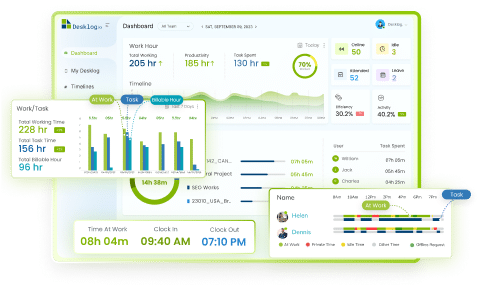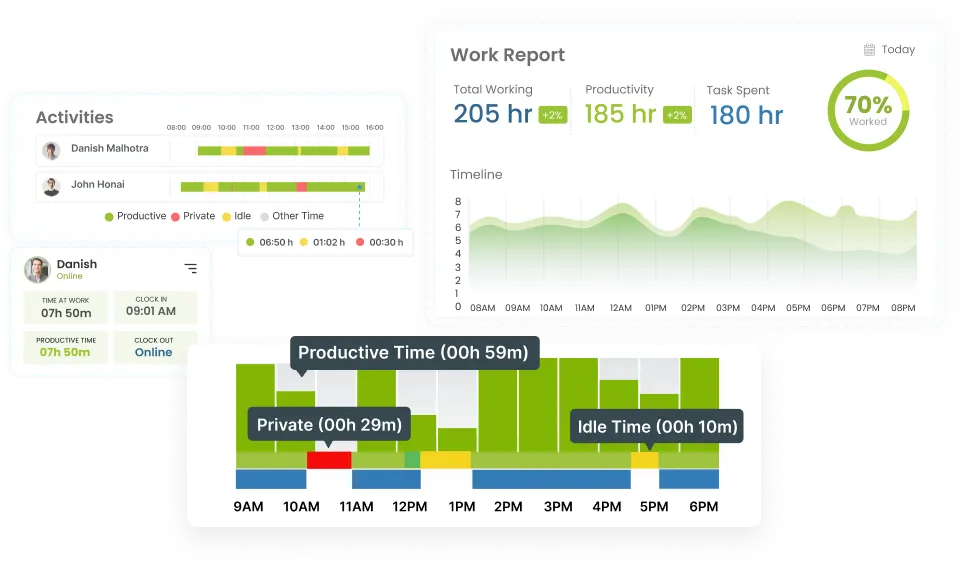We often find ourselves wishing for a miracle, hoping that everything will just fall into place without much effort. But the truth is, an easy, effortless life doesn’t just happen. We have to take action to make our lives beautiful. The problem is that we tend to see everything as a burden, especially time. We often make excuses to avoid tasks, and in the end, this leads to chaos and missed opportunities.
What we need is a better approach to managing time, something that goes beyond simple time management. We need time mapping, a method of structuring our entire work schedule into a clear, visual map. This technique allows us to analyze how we spend our time and create a balanced, efficient flow. If doing this manually feels overwhelming, there is time tracking software to help automate the process.
With so many tools at our disposal, there’s no reason to let poor time management hold us back. Time mapping can be the key to eliminating last-minute struggles and finding a better rhythm in our daily lives. Let’s use this approach and take control of our time, because with the right structure, we can turn chaos into clarity.
What Is Time Mapping?
Time mapping is a time management technique that involves creating “maps” to visualize important activities. Similar to how a map helps you to find a destination, a time map provides a clear picture of how you’re spending your time and how much you’re accomplishing. This helps you assess your time usage and make adjustments to improve productivity.
While traditional time management methods have mostly focused on work-related tasks, the shift to remote and hybrid work has made the lines between personal and professional life less distinct. Consequently, time mapping has gained popularity among professionals seeking to manage both areas more effectively.
Key Elements of a Time Map
-
Time Blocks: Designated periods set aside for specific activities.
-
Categories: Organizing tasks into groups such as work, family, self-care, and recreation.
-
Visual Cues: Using color-coding or labels to distinguish different tasks.
-
Flexibility: Allowing space for adjustments or unforeseen events.
-
Buffer Time: Incorporating short breaks or extra time to avoid burnout.
Structure of a Time Map
A typical time map might include:
-
Daily Segments: Divides the day into specific hours or task-focused sections to plan when each activity will occur, ensuring a structured routine.
-
Weekly Snapshot: Provides a high-level overview of how tasks are spread throughout the week, helping you balance workload and personal commitments.
-
Time Blocks: Allocates set periods of time for focused tasks, reducing workplace distractions and improving employee productivity.
-
Categorization: Uses colors or labels to distinguish between work, personal, and leisure time, helping you ensure balance and prevent overlap.
-
Visual Indicators: Employs icons or symbols to represent activities, making it easy to quickly identify tasks and track progress.
Time Mapping Vs Time Boxing
Time Mapping gives you a comprehensive view of how you allocate time across both work and personal activities. It helps you prioritize tasks, identify inefficiencies, and improve your overall work-life balance. By visualizing your time distribution, you can make informed adjustments to increase productivity and ensure you’re dedicating the right amount of time to key areas of your life.
Time Boxing, on the other hand, is a more structured technique where you allocate a fixed amount of time, or “box,” for a specific task. Once the time is up, you stop working on that task, regardless of whether it’s finished.
This method encourages focus by imposing a strict deadline, which helps to curb procrastination and increases productivity by forcing you to work efficiently within the time limit. The key benefit of timeboxing is that it prevents overthinking or perfectionism by limiting the time spent on any one activity.
Step-by-Step Guide to Time Mapping
Step 1: Evaluate Your Time Usage
-
Reflect on Your Current Routine: Think about why you’re implementing time mapping. What are your expectations? Are you happy with how your time is spent? Identify areas for improvement based on your current habits and productivity levels.
-
Consider Your Peak Productivity Hours: Are you most productive in the morning, afternoon, or evening? Tailor your time map to reflect these natural energy patterns. For example, schedule high-priority tasks during your most productive hours.
-
Use Time Tracking Tools: To get an accurate picture of your current time usage, consider using time tracking software like Desklog to track your work patterns and gain deeper insights into your efficiency.
Step 2: Assess Your Habits and Activities
-
Identify Personal Habits: Reflect on your daily habits, such as when you need breaks, when you’re most alert, or any recurring activities (e.g., walking your dog at 8 a.m.). This helps you better plan around your natural rhythms.
-
Recognize Your Peak Productivity Times: Pay attention to when you feel most focused and active. Are you a morning person, or do you work better late at night? Adjust your time map accordingly to match these productivity patterns.
-
Understand Your Needs for Breaks: Determine how long you need to rest between tasks to maintain focus and prevent burnout. Incorporate appropriate break times into your schedule.
Step 3: Create a Task List and Categorize Tasks
-
List All Tasks: Write down everything you need to accomplish within a specific time frame; both personal and professional tasks. Make sure to include long-term goals and daily tasks.
-
Categorize Tasks: Group similar tasks into categories like work, personal, family, exercise, and leisure. This makes it easier to visualize your day and ensure a well-rounded schedule.
-
Use color-coding for each category to make it easier to differentiate tasks visually. For example, blue for work, green for personal time, yellow for exercise, etc.
Step 4: Prioritize Your Tasks
-
Classify Tasks by Importance: It’s not enough to just list tasks; you need to prioritize them. Which tasks are most urgent or important? Which ones can be moved or delegated?
-
Use Prioritization Techniques: Popular methods like the Priority Matrix (dividing tasks into urgent/important categories) can help you determine what needs your immediate attention.
-
Balance your priorities: Select a few key tasks from each category to ensure your schedule doesn’t become too skewed toward one area (e.g., work vs. personal time).
Step 5: Build a To-Do List for a Short Timeframe
-
Create a List for a Week: Start by planning your time for the next week, breaking down your tasks into smaller, manageable chunks.
-
Limit Categories: Keep your categories to 3-5 main areas (e.g., work, health, family, leisure). This helps avoid overwhelm and keeps your schedule focused.
-
Set Realistic Goals: For each category, set achievable tasks within your time frame. Avoid overloading your schedule.
Step 6: Add Color Codes to Your Time Map
-
Make It Visual: Use different colors for each category to make the map visually engaging and easy to read. Color-coding helps you quickly see which areas need more focus.
-
Align Colors with Categories: Choose colors that resonate with the tasks. For example, blue for work-related activities, green for health or family time, and orange for personal development or leisure.
Step 7: Structure Your Map by Placing Tasks in Time Blocks
-
Block Out Your Time: Start placing your tasks into specific time blocks on your calendar. Allocate time for each task, ensuring that you have set periods for focused work, breaks, and personal activities.
-
Set Fixed Times for Repetitive Tasks: Schedule recurring activities (e.g., meals, workouts, family time) at consistent times to establish a routine. Include buffer time between tasks to accommodate delays and prevent burnout.
-
Prioritize High-Impact Tasks: Place your most important tasks at the times of day when you’re most productive. For example, tackle major projects in the morning if you’re a morning person.
Step 8: Create the Visual Schedule
-
Use a Calendar or Planner: Visualize your time map by using a digital or physical planner. Map out your time blocks clearly so that you can see your daily, weekly, or monthly schedule at a glance.
-
Incorporate Breaks: Don’t forget to schedule regular breaks, buffer time, and rest periods to avoid fatigue and to stay refreshed.
-
Ensure Flexibility: Life can be unpredictable, so your map should have some flexibility. Include space for unexpected events or adjustments.
Step 9: Implement and Adjust Your Time Map
-
Follow Your Map: Start following your time map as closely as possible. Stick to your time blocks, but be mindful not to over-schedule yourself.
-
Stay Flexible: Life changes, and so should your time map. Be ready to adjust it as priorities shift or new tasks arise. Flexibility is key to staying productive and managing stress.
-
Review your time map regularly to assess how well it’s working for you. Adjust your time allocations as necessary based on what’s working and what isn’t.
Step 10: Review and Improve
-
Evaluate Your Map Periodically: Regularly review your time map to see what’s working and where improvements can be made. Maybe some tasks need more time or others less.
-
Tweak as Needed: Fine-tune your map based on ongoing feedback from your experience. Adjust your time blocks, prioritization, or breaks to enhance productivity and improve work-life balance.
-
The more you use your time map, the better you’ll understand your own productivity patterns. Continuously adjust to make your map more effective over time.
By following these steps, you’ll be able to create a comprehensive and flexible time map that helps you manage your time effectively, prioritize important tasks, and achieve a balanced, productive life.
Tools for Effective Time Mapping and Time Management
When it comes to time mapping, analyzing how you spend your time is crucial for creating a structured plan. Several productivity tools can help you track, analyze, and optimize your time usage, ensuring that you make the most of your hours. Below are some key tools that can assist you in evaluating your time and improving your productivity:
1. Desklog: The Ultimate Workforce Management and Time Tracking Solution

Desklog is a complete time management platform designed to optimize time tracking, productivity, and accountability. Its automated time tracking features, including Clock In/Clock Out, Idle Time Tracking, and Offline Time Tracking, eliminate manual data entry, ensuring accuracy and reliability.
With automated timesheets and a web timer, Desklog helps businesses track time spent across various tasks and projects, making resource allocation and budget management more efficient. The platform’s Project Time Tracking offers real-time insights, while its Project Billing & Invoice tools automate billing, ensuring transparent and fair invoicing for clients.
Beyond time tracking, Desklog also enhances productivity with features like Activity Tracking, which tracks employee actions such as app usage and mouse movements. This data helps managers assess performance and foster a culture of accountability.
The Leave Management and Shift Management features streamline employee attendance and scheduling, while ensuring that shifts are evenly distributed to avoid overstaffing or understaffing. Additionally, Desklog offers integrations with popular project management tools like ClickUp and Jira, making it easier to synchronize task data and project timelines.
Desklog excels in time mapping, providing businesses with an accurate and transparent view of how time is spent across tasks and projects. This feature helps businesses track work hours efficiently, whether employees are working remotely or on-site.
Desklog’s time mapping capabilities, combined with its advanced features such as Subtask Management, Overtime Notifications, and Single Sign-On (SSO), make it the ultimate tool for improving workforce management, increasing productivity, and driving profitability.
2. Apploye – For Time Tracking and Performance Insights

Before you dive into time mapping, it’s essential to assess your current work habits. Apploye is a time tracking and productivity app that automatically generates detailed timesheets showing your daily, weekly, and monthly working hours. These reports give you valuable insights into how much time you’re spending on different tasks, including internet usage and productivity levels.
What sets Apploye apart is its ability to track project and task time, allowing you to monitor how much time you’re spending on specific projects or individual tasks. This feature helps you assess your performance, set realistic goals, and maintain focus throughout the day. The app also provides comparative analytics, helping you track improvements over time. By using Apploye, you can stay motivated and stay on top of your work.
3. Microsoft Outlook – Synchronizing Emails and Calendar for Easy Time Management

Microsoft Outlook is a versatile tool that can significantly improve how you manage your time. One of the most time-consuming tasks in any professional setting is managing emails and scheduling. Outlook helps streamline this by automatically organizing your emails and syncing them with your calendar. You can quickly arrange and categorize your tasks, set reminders, and share your availability with others.
Outlook’s integration with task management tools and its ability to manage documents makes it a vital tool for businesses, offices, and even students. By creating a time block for email management and using Outlook’s smart sorting features, you can save time while staying organized and on top of your tasks.
4. Todoist – Task Organization and Prioritization Made Easy

A task management tool like Todoist is essential for time mapping, helping you stay organized and focused on what matters most. Todoist allows you to create and prioritize both personal and professional tasks in one place. Accessible on both desktop and mobile devices, Todoist gives you the flexibility to manage your routine from anywhere at any time.
The app offers reminders, so you’ll never miss a critical task or deadline. You can also categorize tasks by priority, ensuring that your most important tasks are completed first. Todoist integrates with time tracking, automation, and file-sharing tools, making it easier to streamline your day and increase your productivity.
The Benefits of Time Mapping: How It Makes a Difference?
Time mapping offers numerous advantages that can significantly improve your time management and futuristic productivity. Here are the key benefits that make time mapping a best option:

Spend More Time Doing and Less Time Planning
One common pitfall of traditional planning is spending too much time organizing and not enough time executing. Studies show that 88% of workers over-plan. With time mapping, you can plan your tasks for the week or month in one go. Once your time map is in place, you’ll know exactly what to do each day without wasting time on endless planning sessions.

Analyze Your Efficiency to increase Motivation and Performance
Many employees report that they don’t feel motivated by how their performance is managed. Time mapping changes that by allowing you to evaluate your own time usage. You can review how much time you spent on each task, assess which activities were easy or challenging, and track improvements in your efficiency over time. This self-reflection helps increase motivation and improves employee performance, providing insights into how much time you dedicate to work versus personal life.

Break Down Large Tasks into Smaller, Manageable Portions
Time mapping encourages you to divide large, overwhelming tasks into smaller, more achievable pieces. This makes it easier to gauge how long each task will take and prevents procrastination. If you don’t have enough time to finish a big task today, you can work on it in parts and finish it later. This approach reduces the anxiety of tackling large projects and helps you stay on track.

Easily Spot Task Dependencies
In many projects, certain tasks depend on the completion of others. Time mapping allows you to visualize these dependencies clearly, making it easier to prioritize tasks in the right order. By blocking time for each activity, you’ll avoid delays and ensure you’re working on tasks in the most efficient sequence, saving time in the long run.

Improve Your Work-Life Balance
With the rise of burnout and stress in the workplace, time mapping can help significantly improve your work-life balance. It ensures that you allocate time for both professional responsibilities and personal commitments, like family, exercise, or relaxation. By managing your time effectively, you can avoid overworking and prioritize activities that support your well-being, leading to a healthier work-life integration.

Get More Done in Less Time
Time mapping makes tasks seem more manageable by clearly defining the amount of time you’ll spend on each activity. Knowing that a task will only take 30 minutes makes it feel less overwhelming, which can motivate you to get started and complete it more quickly. Often, tasks take less time than we expect, and time mapping helps you realize that, increasing your overall employee productivity.

Take Control of Your Schedule
When you map your time, you’re taking control of your day. By writing down tasks and assigning specific time slots, you’ll never forget what you need to do. You’ll also have the flexibility to adjust your schedule as needed, ensuring you remain in charge of how your time is spent rather than reacting to events as they arise.

Stay Accountable
Time mapping fosters accountability. When you block time for tasks and track your progress, you are responsible for following through. You can also use it to cooperate more effectively with others, as they’ll know exactly how much time you’ve allocated to various projects. This creates trust and helps you stay disciplined in meeting deadlines.

Create Flexible Schedules with Breaks and Buffer Time
Time mapping also helps you stay flexible. By breaking tasks into smaller steps and recognizing dependencies, you can adapt your work schedules on the fly. You can also build buffer time into your map to account for unexpected events or delays. This flexibility ensures you stay productive without feeling stressed.

Enhance Efficiency and Optimize Time Utilization
Time mapping improves efficiency by allowing you to plan tasks clearly, reducing the time spent on decision-making. You can dedicate more time to executing tasks rather than figuring out what to do next. Whether you’re working individually or in a team, time mapping helps optimize time usage, so you can focus on what’s important and get more done.

Improve Work-Life Balance and Well-Being
Since the pandemic, employees’ work-life balance has suffered, with stress levels and burnout increasing dramatically. Time mapping is an effective tool for improving this balance by ensuring that both personal and professional commitments are properly managed. By allocating time for relaxation, family, and self-care, time mapping helps reduce stress and create a healthier lifestyle.

Use Time as an Asset, Not Just a Limitation
Instead of fitting your tasks around the time available, time mapping flips the script by allowing you to think about how much time each task requires and then fitting your schedule around it. This proactive approach makes time a valuable asset, implementing productivity trends and enabling you to make the most out of each day.
Wrap Up
Time mapping is a powerful technique that helps you take control of your day, optimize your productivity, and achieve a better work-life balance. By visually organizing your tasks into time blocks and prioritizing what truly matters, you can reduce inefficiencies, stay focused, and avoid burnout.
It allows you to proactively plan your time, ensuring that both personal and professional goals are met. Remember time mapping empowers you to make the most of each day, turning time from a limitation into a valuable asset that propels you toward success.
FAQ
1 What is a Time Map?
A time map is a tool used for managing time by creating a structured timeline for completing key personal and professional tasks. It helps users better understand how their time is being spent and allows them to make adjustments to improve efficiency and productivity.
2How is Time Mapping Different from Time Management?
Time mapping is a more visual, detailed approach to managing time. While traditional time management focuses on making to-do lists or setting deadlines, time mapping involves creating a structured, visual “map” that outlines how time will be allocated across various tasks. It helps you see the bigger picture and identify inefficiencies by categorizing tasks into time blocks, which can help balance work and personal life more effectively.
3How Do You Create a Time Map?
To create a time map, start by listing all your tasks and categorizing them as either ‘personal’ or ‘professional.’ You can do this using a traditional pen-and-paper method or digital tools like Microsoft Excel or Outlook for easier tracking. Once your tasks are listed, assess the importance of each one, then allocate specific time blocks for them. Finally, review your time map to identify areas where you can improve, optimize your schedule, and make better use of your time to enhance productivity.
4Can Time Mapping Work for Teams or Groups?
Yes, time mapping can be highly effective for teams. In a group setting, it allows members to visualize how their individual tasks fit into a larger project timeline. It can enhance collaboration, clarify team priorities, and improve overall project management by ensuring everyone is on the same page regarding time allocation and deadlines.
5Why is Time Mapping Important?
Time mapping is a method that involves creating a visual representation of your key activities, similar to a road map that guides you to your destination. It helps you understand how you’re using your time and assess how effectively you’re completing your tasks. By analyzing your time usage, you can make adjustments to enhance productivity and achieve your goals more efficiently.
6How Do I Adjust My Time Map if Unexpected Events Arise?
Flexibility is a key principle of time mapping. If unexpected events arise, you can adjust your time map by reallocating time blocks or shifting tasks around. Incorporating buffer time and recognizing the need for flexibility when mapping your time ensures you’re able to adapt without disrupting your productivity.
7What Are the Benefits of Time Mapping?
Time mapping offers several advantages, including improved efficiency, better time management, and a more balanced work-life dynamic. It enables you to optimize how you spend your time and treat it as a valuable resource to help you achieve both personal and professional success.
8What Tools Can I Use for Time Mapping?
There are various tools available to create and track time maps. Digital planners like Google Calendar, Trello, or Asana are popular for time mapping, as they allow for easy task categorization, color coding, and time-blocking. You can also use dedicated time management apps such as Desklog, Todist, Notion etc. which allow you to create visual task lists and track progress.
9Can Time Mapping Help with Overcoming Procrastination?
Yes, time mapping can be a powerful tool for overcoming procrastination. By breaking tasks into smaller, manageable time blocks, it removes the overwhelm that often leads to procrastination. Knowing exactly when and how much time you’ll spend on each task creates a sense of urgency and focus, helping you take action and stay on track.
10How Often Should I Review and Update My Time Map?
It’s important to review and update your time map regularly to ensure it remains aligned with your goals and changing priorities. For most people, reviewing it at the end of each week works well, allowing you to adjust for the upcoming week. However, if you’re working on longer-term projects, it may be helpful to revisit your map monthly. Regularly evaluating your time map helps you identify what’s working, tweak inefficiencies, and stay motivated.

















